

50+ Business-Building Local SEO Tactics For SMBs
source link: https://www.searchenginejournal.com/page-1-google-rankings/443619/
Go to the source link to view the article. You can view the picture content, updated content and better typesetting reading experience. If the link is broken, please click the button below to view the snapshot at that time.
10 Different Ways To Get Organic Page 1 Google Rankings
Discover 10 ways to go beyond the old 10 blue links and get more traffic from Google's enhanced organic search results.
-
SHARES
-
READS

Google search has been continually evolving since the very beginning.
Over the past 10 years, much of that evolution was driven by improvements in technology but also changes in what users expect.
Here are 10 opportunities for more traffic from Google and how to get it.
Google has steadily been committed to making search results more useful and also in response to changing user behavior, lately driven by the new demands of mobile search.
With the introduction of knowledge panels in 2012 followed by featured snippets in 2014 – not to mention the local search packs that preceded that – optimizing for 10 blue links has become anachronistic.
It’s an SEO practice from the past.
Rich results, featured snippets, Map Pack results, knowledge panels, and more are opportunities for more site visitors from an increasingly dynamic search results page.
How can you compete? By staying up-to-date.
In this post, we’re going to explore the different ways you can appear on Google’s Page 1 by optimizing content for various types of search results.
Note: this is in no way comprehensive and is ever-changing, as Google constantly tests and launches new features (and sometimes takes our favorite toys away).
Core Types Of Rich Search Results
The examples below will fall into one of these categories (and there may be some overlap):
- Rich Results.
- Featured Snippets.
- Knowledge Panels.
- Local Business Results.
Rich results are enhanced organic search result that adds information to a plain text search result and expands it as a result.
Rich results make your results more dynamic, visible, and engaging.
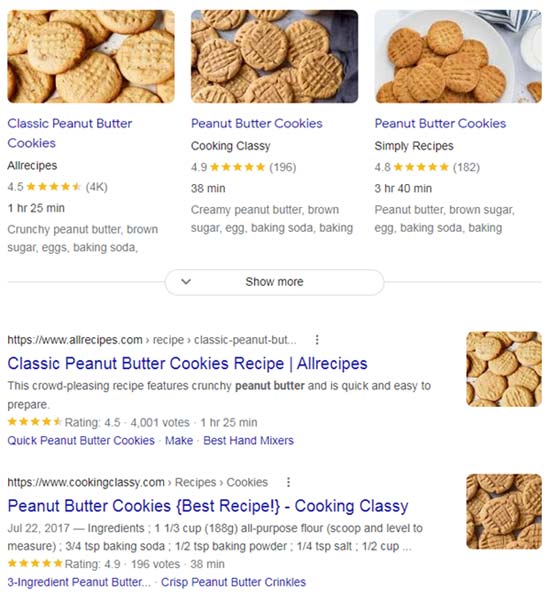 Screenshot from search for [peanut butter cookies recipes], Google, March 2022
Screenshot from search for [peanut butter cookies recipes], Google, March 2022Sometimes referred to as “position zero,” it’s actually position 1 out of the traditional 10 organic positions.
These results are enhanced organic search results that contain additional visual enhancement, including stars, as part of a carousel of search results and may include images from multiple websites.
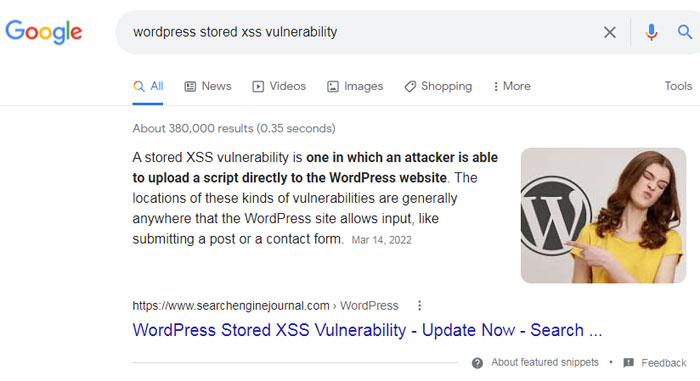 Screenshot from search for [wordpress stored xss vulnerability], Google, March 2022
Screenshot from search for [wordpress stored xss vulnerability], Google, March 2022This search result typically answers an informational query and may include text, a numbered (or non-numbered) list, and images (sometimes from multiple sites).
Featured snippets make your organic search listings more dynamic, visible, and engaging.
Research data from different sources in 2020 and also 2021 estimates that featured snippets display in the search results between 11% and 19% of SERPs.
Unlock (not provided) with Keyword Hero
See all your organic keywords in GA and their specific performance metrics. Free Trial. Cancel anytime. Professional support. 4-minute setup.
It’s important that you’re optimizing for the search results enhancements that make sense within the context of your business goals and searcher intent.
Knowledge panels are information panels about what is generally referred to as entities. What is meant by the word entities are people, places, organizations, movies, music, and other things.
Knowledge panels provide quick information about entities that are automatically generated.
The entities that are subjects of knowledge panels have the opportunity to “claim” a knowledge panel and influence the information that is in that knowledge panel.
Google also accepts user feedback about knowledge panels.
Knowledge panels are an opportunity for organizations and individuals to present their information through Google.
Google Business Profile (formerly known as Google My Business) is a Google program that allows local-based businesses to manage their online presence whenever someone searches for their business, a local product, or a service.
The data in Google Business Profile powers the local Map Pack in the organic search results.
It helps to surface the correct information in Google Maps, and it provides a way to control the business profile shown in Google’s search results including things like phone numbers, addresses, and hours.
Check out a comprehensive overview of Google Business Profile if you’re just getting started or looking for improvements in that area.
The likelihood that you’ll earn a result in one of these formats depends on hundreds of factors that only Google knows, but you can safely assume that these weigh heavily into the mix:
- Relevance to the query.
- Vertical, industry segment, or category (such as flights, hotels, or restaurants).
- Correct use of structured data.
- Content quality.
Here are 10 ways you can get more Page 1 – and Position 1 or even the coveted Position Zero – results in Google.
For each one, you’ll find tips and resources to help you optimize for that type of result (although this is in no way a guarantee that you’ll achieve it).
1. Plain Text Organic Search Results
Achieving the top plain text organic search result in Google is more difficult than ever before.
Not only is search extremely competitive, but search results consisting of just plain blue links are becoming rare for certain kinds of questions, particularly “how-to” type search queries.
As for ten blue links, those essentially don’t exist anymore on mobile devices because search results on mobile are shown with a continuous scroll so that users no longer have to click to the next page of search results.
 Screenshot from search for [should publishers use link disavow tool?], Google, March 2022
Screenshot from search for [should publishers use link disavow tool?], Google, March 2022How To Optimize For It
- Answer a searcher’s need for information.
- Be superior in every way. Seriously, that’s what it takes.
2. Video Rich Results
It’s no surprise that YouTube results feature prominently in Google’s search results.
Until last year, videos appeared as a thumbnail alongside the blue text link.
Now, Google organizes them into Video Rich Results that are sometimes displayed above the regular text link results.
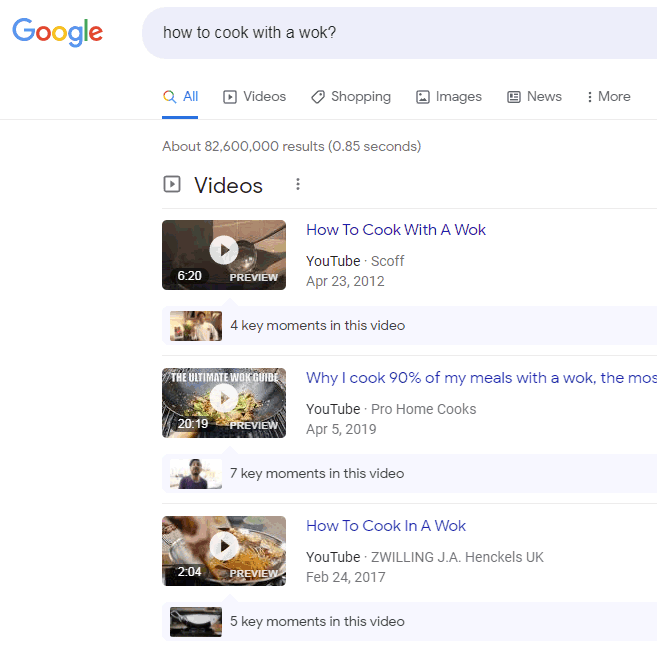 Screenshot from search for [how to cook with a wok?], Google, March 2022
Screenshot from search for [how to cook with a wok?], Google, March 2022How To Optimize For It
- Help searchers and search engines understand your video’s content with relevant, quality titles, descriptions, and tags.
- Use the appropriate VideoObject Structured Data.
3. Carousel Rich Results
Google’s documentation states that carousel rich results are available for four specific kinds of content:
- Course
- Movie
- Recipe
- Restaurant
It also appears to be available for other entertainment media besides Movies, like podcasts, and even for Victorian-era authors.
 Screenshot from search for [authors of victorian fiction], Google, March 2022
Screenshot from search for [authors of victorian fiction], Google, March 2022How To Optimize For It
4. Featured Snippet
A type of organic search result that displays approximately 50 words of text, the page title and URL, and a featured image thumbnail.
Featured snippets are an excellent opportunity to get more eyes on your thought leadership material.
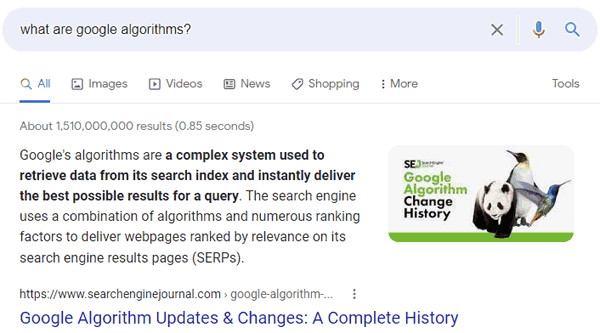 Screenshot from search for [what are google algorithms?], Google, March 2022
Screenshot from search for [what are google algorithms?], Google, March 2022How To Optimize For It
- Answer informational queries relevant to your business and its products or services.
- Keep this paragraph format and a simple Q&A approach in mind as you create content you hope to rank on this type of result.
- Do the legwork of researching what questions people have and see what results come up. Are there opportunities where no result renders? Are there results that seem low quality or outdated? Start there and use your learnings from those early efforts with the easiest opportunities to target more competitive search terms.
5. Data Table Snippet
Tables can be an effective way to share information or demonstrate concepts.
Note that Google initially developed this result for news media.
However, as brands increasingly function as publishers and may even tackle timely news stories, this could be an opportunity for businesses, as well.
Google is also able to read data that is displayed in HTML tables (without structured data) and display them as a Data Table Snippet.
 Screenshot from search for [europe search engine market share], Google, March 2022
Screenshot from search for [europe search engine market share], Google, March 2022How To Optimize For It
- Explore Google’s approach to dataset discovery and find developer resources here.
- Read more about displaying data tables in search results here.
6. Top Stories Carousel
The Top Stories carousel displays the headline, source name, and an expanded image. These results are open to blogs as well as media websites.
Proper optimization here can result in your article being automatically converted into action on Google Assistant, enabling people to access your content through the voice assistant.
 Screenshot from search for [google search label for cited sources], Google, March 2022
Screenshot from search for [google search label for cited sources], Google, March 2022How To Optimize For It
- Google will display news content in the top stories carousel regardless if the article is published in AMP or not.
- What is important is that the webpage uses the correct structured data in order to pass along relevant information that can be used to show in the Top Stories section of Google’s search results.
- Additionally, be sure to use the right size featured image. It is recommended by Google that images for AMP pages be a minimum of 1200 pixels wide.
- For non-AMP pages, Google’s article structured data developer page recommends a minimum of 696 pixels wide. However, Google’s guidelines for the Google Discover program recommend all pages use images with a minimum of 1200 pixels in width. So for Google News, it’s best to use images that are a minimum of 1200 pixels wide in order to remain eligible for being shown in Google Discover as well as Google News.
7. Local Business Knowledge Panel Card
With the proper markup and optimizations, business panels can have a great deal of functionality and interactivity.
Not only can searchers find your address, phone number, and hours of operation without clicking through to your site, but they may be able to complete actions such as booking a table, placing an order, or making an appointment.
Your panel expands as more relevant information is added, making it incredibly hard to miss on both desktop and mobile.
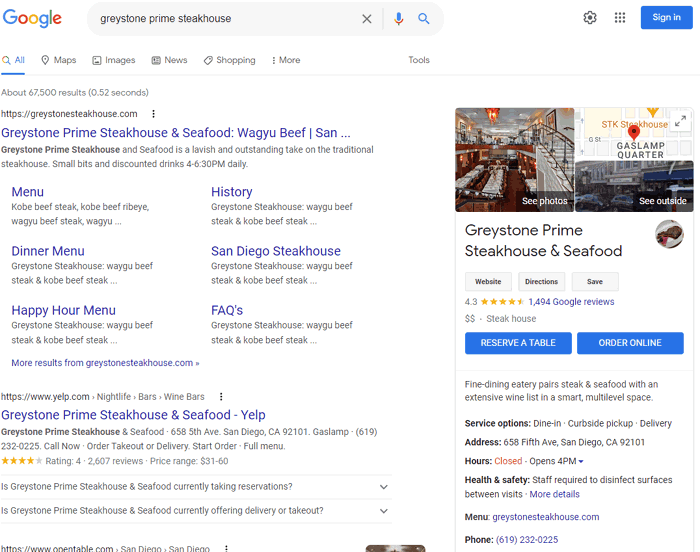 Screenshot from search for [greystone prime steakhouse], Google, March 2022
Screenshot from search for [greystone prime steakhouse], Google, March 2022How To Optimize For It
- Expand your panel as much as possible by populating your Google Business Profile (GBP) with descriptive, relevant information to help searchers make a decision about your business.
- Monitor your GBP dashboard and interact regularly with searchers who leave reviews, ask questions, or otherwise attempt to engage your business.
- Keep all information up-to-date in order to avoid poor searcher experience (such as directing someone to a closed location) and eroding search engine trust in your brand.
- Find specific markup to facilitate actions such as reservation taking or online ordering here.
8. Event Rich Result
Marking up your events pages with Event Structured Data helps this information appear in Google Search and Maps results.
Searchers can also click through to see more events and filter by date.
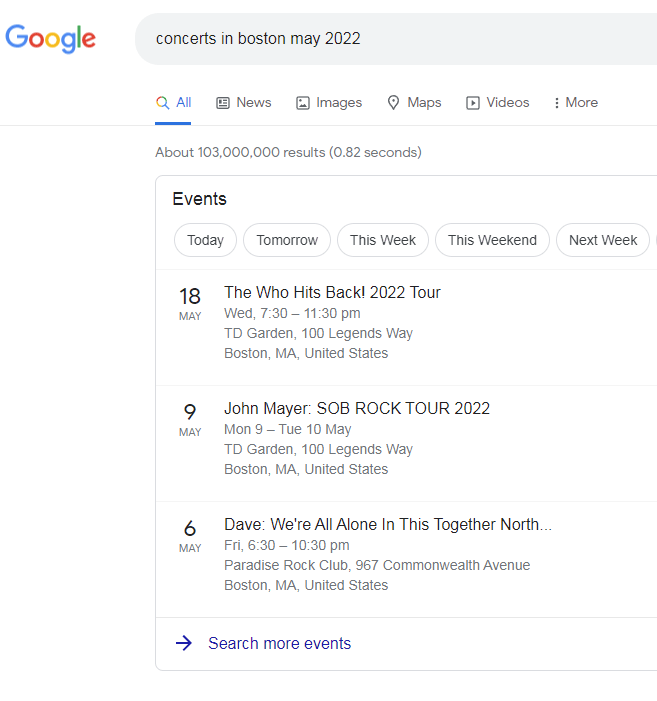 Screenshot from search for [concerts in boston may 2022], Google, March 2022
Screenshot from search for [concerts in boston may 2022], Google, March 2022How To Optimize For It
- For the occasional event or just a few on your website, use Google’s Data Highlighter.
- Apply the proper Events markup.
9. Review Snippet
When Google finds the proper markups for reviews, it may expand your rich result with a review excerpt or an average combined rating score.
Currently, this rich search result type is available for books, local businesses, movies, music, products, and recipes.
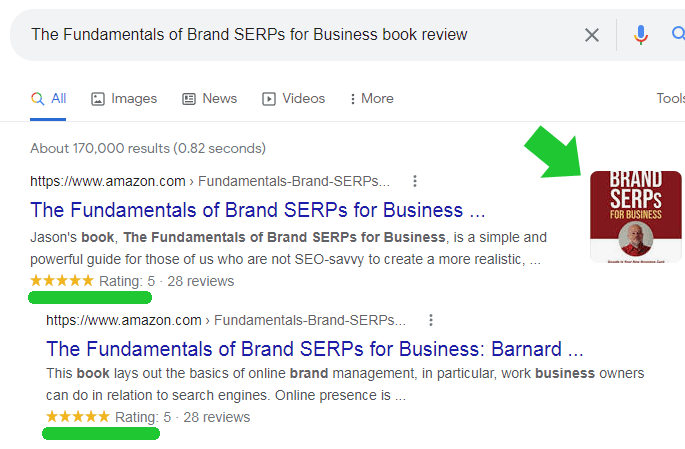 Screenshot from search for [the fundamentals of brand SERPs for business book review], Google, March 2022
Screenshot from search for [the fundamentals of brand SERPs for business book review], Google, March 2022How To Optimize For It
- Follow Google’s instructions here for optimization whether you want to add a simple review, embed a review into another schema.org type using its review property, add ratings to your reviews, or add aggregate ratings.
10. Logo In Knowledge Panel & Search
Reinforce your branding at every opportunity by ensuring that your logo appears in your business panel and in Search.
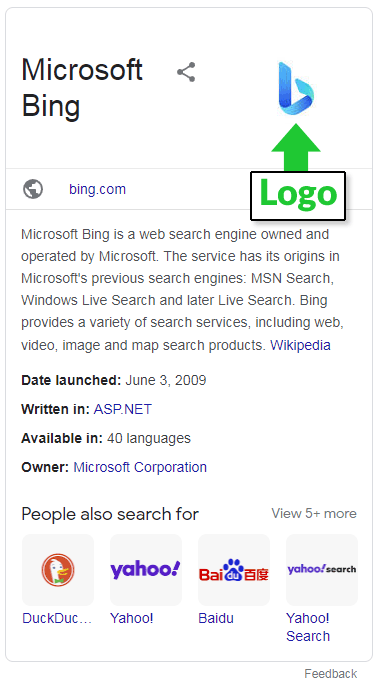 Screenshot from search for [bing], Google, March 2022
Screenshot from search for [bing], Google, March 2022How To Optimize For It
- Use a logo that is 112 x 112px, at minimum, in .jpg, .png, SVG or WebP format.
- Make sure that the image URL is crawlable and indexable.
- Apply the proper markup.
Overall Best Practices For Rich Search Results Optimization
- Follow Google’s structured data guidelines. It’s pretty important to them that you do so, as evidenced by their guide entitled (you guessed it): Follow the structured data guidelines.
- If you’re just getting started, try out Google’s Structured Data Codelab to experiment with several different types of structured data in a controlled, instructive environment.
- Use Google’s Rich Results Test to see if your page supports rich results and get recommendations to improve.
- Avoid being perceived by Google as a structured data spammer by resolving issues and avoiding shady behavior such as marking up content that isn’t visible to users.
- Run Google’s Rich Result Status Report after implementation and regularly as you continue to optimize your site’s content. You’ll see which rich results Google could or couldn’t read from your site and get troubleshooting information for rich result errors. You can then request a re-crawl after you have fixed any problems.
These are just a few of the more universally appealing ways to get multiple Page 1 results. There are plenty more, especially once you get into vertical-specific results.
Before chasing any one type of result, make sure you understand the opportunity, competition, and searcher intent you hope to get in front of with that specific type of content.
Enhanced Search Results Are An Opportunity
The concept of search results as a listing of 10 blue links is a thing of the distant past.
The various rich search results provide myriad opportunities to be discovered in a way that provides new opportunities to cultivate more meaningful traffic than ever before.
More Resources:
Featured Image: Zouls/Shutterstock
Subscribe to SEJ
Get our daily newsletter from SEJ's Founder Loren Baker about the latest news in the industry!

Miranda Miller
Writer, editor & marketing professional; digital nomad, feminist and mother bear. 15 years of experience planning & executing engaging digital ... [Read full bio]
- Suggested Articles
-
SHARES
-
READS

Do you have a local small to medium-sized business (SMB)?
If so, you know just how difficult it is to get found and stand out in increasingly competitive search results.
Local SEO strategies must adapt to new features and algorithm updates by the top search engines that affect local search results.
Most local SEO tactics fall into the following three categories.
- Optimizing local listings and citations.
- Optimizing your website and its content.
- Optimizing and working on incoming links.
In this column, you’ll find over 50 specific things you can do right now to help improve your visibility in local search results, divided into those categories above.
Optimizing Local Listings & Citations
Let’s start with your NAP (Name, Address, and Phone Number) data.
In order to get listed and ranked in Google Maps, you need to be a legitimate business, and in some areas, you’ll need a business license (depending on the type of business you’re in).
That NAP needs to be consistent and listed the same everywhere or you’ll have problems later on.
Before you get started with local listings and citations, you’ll also need the following:
- NAP of the business.
- Website URL (list of internal location pages if more than one location).
- A short description (up to 50 characters) that should include your main city name and type of business.
- A longer description (up to 250 characters) that describes who you are and what you do. Include the city name and areas served if applicable.
- Recent photos of your business.
- Category of your business.
- Keywords (that you’d like to rank for). These are typical “city name keyword” type keywords.
The main strategy for local listings and local citations is to get as many as feasible in the right category, with consistent information such as your NAP data.
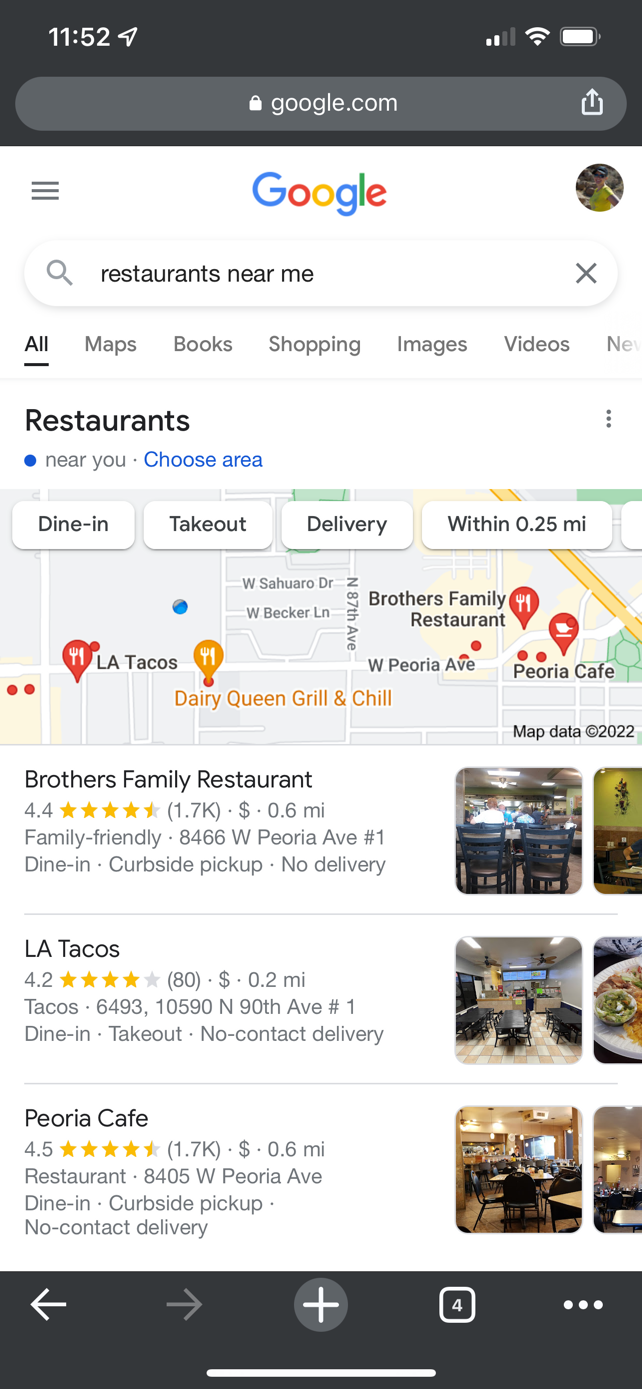 Screenshot by author, March 2022
Screenshot by author, March 2022Local citations are mentions of a local business, which includes NAP data. Local citations may or may not include a link to your website. There are generally two strategies for getting local citations:
- Get the local listings yourself.
- Hire someone else to get them for you.
Taking the time to get local citations yourself can be a really big project, especially if you’re in a competitive industry in your area.
Competitors could have up to hundreds of thousands of local citations, which is nearly impossible to do manually.
If you’re a local business (SMB) in a fairly non-competitive market, then getting a handful of local citations manually is a good strategy. If that’s the case, a non-competitive local SEO strategy for local citations is to get these listings:
- Google Business Profile.
- Facebook.
- Yahoo! Local (currently requires a payment to Yext).
- Apple Maps.
- Bing Places for Business.
- MapQuest.
- Yelp.
- BBB.org.
- FourSquare.
- TripAdvisor.
- Angie’s List.
- TrustRatings.
- YellowPages.
- Home Advisor.
- Thumbtack.
The last two on the list are specific to certain industries, and you’ll want to search certain directories that are specific to your local business’ industry.
Typically, these are easy to find — they’ll rank in the top 10 search results (on the first page).
BrightLocal has a list of top local citations for the U.S. that they maintain.
Submitting to directories (and getting listed) will allow your local business to take advantage of what’s often referred to as “barnacle SEO.”
Your business gets listed on pages on other websites that rank well for a certain keyword you’re targeting.
So for [Dallas carpenters], Google lists sites like Yelp.com, homeadvisor.com, thumbtack.com, houzz.com, and angi.com.
Getting listed on those sites will bring the business leads, as they’re ranking well in Google.
Once you have secured (and verified) those local listings, the next local SEO strategy is to get listed with the main data aggregators. There are three:
- Data Axle (formerly InfoGroup) – Submit your business here.
- Acxiom – Register then submit your business here.
- Localeze – Register then submit your business here.
The data aggregators will take the information of the local business and aggregate it (make it available for literally thousands of websites to use).
Be sure you’re using the correct NAP data and website URLs, as once the data aggregators get hold of your data, it’s tough to get it corrected and updated and can take quite some time.
Using A Third Party For Local Citations & Listings
Another local SEO strategy is to outsource local citations and listings.
Several third-party businesses allow you to submit your local business listing to them (the NAP data, short and long descriptions, URLs, etc.), and they will then use their connections to get that data on other websites.
Many have agreements with certain data providers, and can efficiently get hundreds, thousands, and even hundreds of thousands of local citations.
These third-party services include:
- BrightLocal.
- MozLocal.
- Yext.
- Advice Local.
- SEMrush Listing Management Tool.
- Whitespark.
- Synup.
Some of these services are better than others, mainly because of the agreements they have with other websites and their technology.
Some submit to only 30 websites, and others like Advice Local will end up getting a local business thousands upon thousands of local citations, many of which include a link to the website.
Be wary of any third-party websites that set up a local listing on behalf of the local business but won’t give the local business the login and password for those listings.
Reviews Are Key
Getting reviews of your local business, especially on Google, is going to help rankings and it will encourage others to visit your business.
People do read reviews online, especially for service-type businesses (hotels, resorts, carpet cleaners, home inspectors, carpenters, and even car dealerships).
So, if your local business is a service-type business or another business where reviews are important, then creating a good strategy for dealing with reviews is key.
Local businesses need to request and encourage their customers to leave a review.
There are a lot of ways to encourage customers to leave a review.
Some businesses post a plaque at the business asking for reviews. Other SMBs encourage reviews by offering a “prize” each month to a random reviewer (one local business I frequent gives away an Apple iPad once a month to a random reviewer).
The local business should respond to reviews just as quickly as they are left, regardless if it’s a positive or negative review.
If it’s a positive review or comment, thank the customer for leaving a review.
If it’s negative, deal with it quickly and offer to take the issue offline to minimize any future problems and the negative review getting out of hand.
Even if you miss responding to a review, it’s perfectly okay to respond to reviews left several months in the past.
If the review shows up and can be seen easily, then I recommend responding to the review.
Too many local businesses will take the time to verify their local listings but won’t properly deal with reviews and respond to them in a timely manner.
Local businesses should take the time to develop a strategy for encouraging reviews, tell employees what that strategy is, and designate one or two people to respond to reviews.
Here are a few other ways to manage reviews:
- Designate one or two employees to read reviews and handle review responses.
- Encourage reviews by asking your customers when they check out or pay for services.
- Send customers a letter or postcard in the mail, asking for a review after you provide services.
- Outsource review monitoring and response. Typically, your social media or SEO company (or consultant) will help monitor and respond to reviews. If not, hire someone part-time to handle it for you.
- Add a link on your website to a few other places where customers can leave a review. On the Google Maps listing, for example, Google provides a link to the listing that you can share.
- Add a form on your website so they can anonymously leave a review (or leave their contact info if preferred). There are plugins available that will help you post those reviews on your website. This is especially helpful for businesses that sell products directly on their websites.
- Create a comment box at your business, and provide a pen/pencil and forms. On the form, add a line for the customer’s email address. Ask them if you can post their review or testimonial online. Or, if you have their email address, email them and ask them to leave a review online.
Reviews sent directly to the business can be posted on the company’s website (with the permission of the customer). Reviews left on a third-party website (like on Google, Yelp, etc.) cannot be copied and posted on the company’s website.
Reviews on third-party websites have in fact been given extra weight lately by Google. So sites like these, where customers can leave reviews and feedback, could potentially help with local rankings on Google:
- Yelp (yelp.com).
- Trip Advisor (tripadvisor.com).
- Yellowpages (yp.com).
- Better Business Bureau (BBB.org).
- Manta (manta.com).
- Angie’s List (angieslist.com).
- Foursquare (foursquare.com).
- Facebook (facebook.com).
Another way to get more local reviews is to create a postcard or handout that’s given to customers.
Tell them you’d like their feedback, and use that feedback to make your business even better.
They can leave you a review on your website, or on any of these third-party websites (list the websites where you’d like them to leave a review).
Optimizing Your Local Website’s Content
Without going into too much detail about optimizing a local website, there are several on-site local SEO strategies that are important to consider:
- Optimize for “Near Me” search queries.
- Optimize for local.
- Be a local content machine.
- Buy a local website or blog.
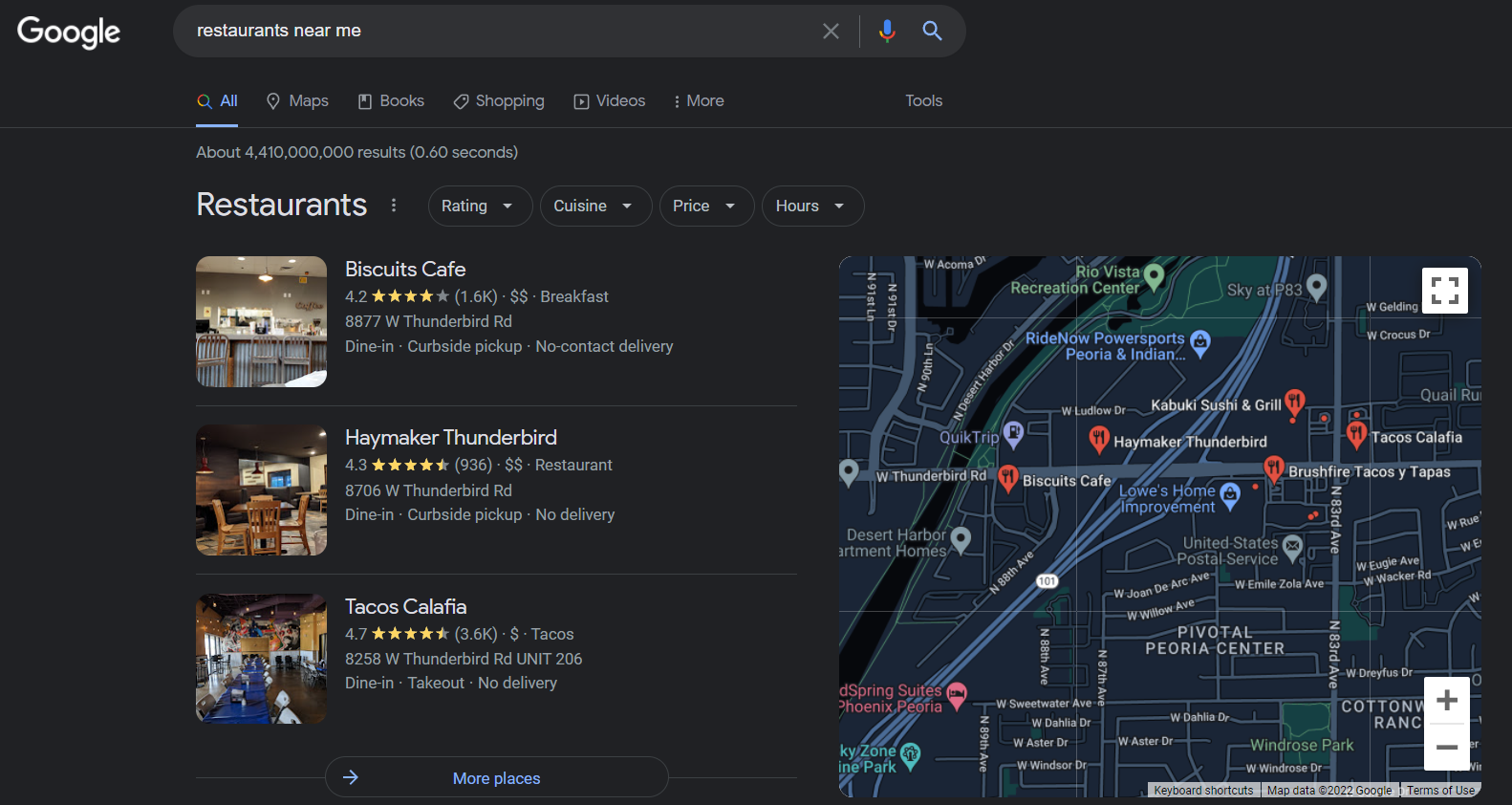 Screenshot by author, March 2022
Screenshot by author, March 2022Optimize For “Near Me” Search Queries
In the past, there have been more people using “near me” in the number of search queries, such as [restaurants near me] or [pharmacies near me].
Those two search queries assume the search engine knows where the searcher is located.
While “near me” isn’t necessarily gaining in popularity as it once was five years ago, it’s still used quite often.
I recommend doing your own keyword research and specifically looking to see if “near me” is used in search queries in your area.
If there’s a significant amount of searches, you may want to optimize at least one page on your website for “near me” related keywords.
Local Ranking Factors
Advice Local came out with their list of 2021 Local Ranking Factors, which is worth reviewing.
Specifically, they found that the local SEO experts that contributed to the list of ranking factors said that these are important:
- Google Business Profile Signals.
- Reviews.
- On-Page.
- Links.
- Behavioral.
- Citations.
- Personalization.
A properly optimized GBP listing is the most important ranking “factor.”
So, it’s important to optimize your Google Business Profile listing.
Reviews are important, as well as responding to those reviews.
Then one of the “rising” important factors is the optimization of your website’s pages, which is the “On-Page” referred to above.
For example, make sure that your website has the proper Local Schema markup code, and the NAP data there matches the information in your GBP exactly, especially the name.
Work on getting more backlinks specifically to your individual location pages that include “city name + keyword” in the anchor text of the links.
Be A Local Content Machine
One interesting tactic or “local SEO strategy” I’ve seen lately that works well is becoming a local content machine.
Essentially, by adding a blog to your local business website and writing about local news and events, you’re producing content that others in the city will want to read and share, especially on social networks.
While you’re not necessarily writing about your local business, you’re branding the business locally. When someone wants or needs a company’s services, they’ll think of your business first since they’ve seen it so much online.
A local auto accident and personal injury attorney hired a writer to write articles every single day about accidents in their city.
While they weren’t targeting the actual victims they wrote about, the social media shares went up dramatically and the attorney got his name out there in front of people in the city.
Those social media shares did end up creating links to the website, which in turn helped local rankings.
Buy A Local Website Or Blog
If you’re looking to add a lot of content fairly quickly to your local business website, consider purchasing a local website that already has the content you need.
It could be a local hobby website with local news or articles, or it could be a local blog that has the content.
Perhaps the owner doesn’t have the heart to keep up with the content like they used to or they could just use the money.
Approach a local website or blog about buying their site and incorporating and moving their content over to your local business website.
Setting up redirects from the old domain name to your local business website will help pass any link equity and history over to your local business.
Optimizing And Working On Links
Links to your website have always been an important search engine ranking factor and will continue to be in the future.
Google’s algorithm has always favored links to a website.
But back in 2016, there was a stronger emphasis on links when Google released its Google Possum algorithm update.
Local links or links from other local businesses and organizations have been important for years, and are still a very important part of a local SEO strategy today.
Greg Gifford, Vice President of Search at SearchLab.com, recommends that you can “find easy link opportunities by looking at the relationships you already have.”
Local sponsorships, local volunteer opportunities, and local offline groups can all lead to local links.
Need more ideas for local links? Use Majestic.com to analyze the link profiles of similar businesses in another city.
Another local SEO strategy for local links is to get links from competitors.
Use a web crawler such as the Screaming Frog SEO Spider to crawl their website and review all of your competitors’ outgoing links.
Then, see if there are any links you can get from websites your competitors are linking to.
Essentially, those competitors are passing link credit or PageRank to the other website that then passes it to your website.
Additional Local SEO Tips
Those are a few local SEO strategies that will help local search engine rankings.
But, if that wasn’t enough, here are a bunch more local SEO tips and pointers that you may not have thought of yet.
Local Listings
Undoubtedly, the number one local search ranking factor is the “proximity of the business to the point of search.”
How far is the business away from the person who is doing the search?
For example, Google knows where the searcher is (especially if they are using a mobile phone).
The closer the business is to the person doing the searching, the more likely that business will show up in the Google Maps and Google local listings in the search results.
Some businesses have been known to get a “virtual office” location (or multiple virtual office locations) just for this reason, especially if the customer never visits their location.
While this is a local SEO strategy I don’t endorse, it’s a local SEO strategy worth noting – as a company’s competitors might be doing it.
Keep your local online listings up to date.
If you know you have an update to your NAP data, make sure it gets changed online as soon as possible.
If you’re moving, start updating your local listings.
As soon as you know the new address, start updating local listings online.
It can take months for websites to update your listing, so the sooner you start, the better.
Just as you update your “snail mail” with the US Postal Service when you move to a new location, you’ll want to make sure your local listings are updated as well.
As previously mentioned, the address with the USPS should be the same exact address used in your local listings.
Search engines most likely have access to USPS data and inconsistencies can lead to local ranking problems.
Consistency is key when it comes to NAP data and your business’s ability to rank well locally.
Make sure your local listings are consistent and the same as it is on your website.
Audit your local citations.
Inconsistent NAP data across multiple websites is one of the issues I see a lot.
Auditing your local citations to make sure your NAP is consistent everywhere can really help local SEO.
You might have multiple phone numbers, different versions of your address, or even a different address on some websites that list your NAP data.
Removing duplicate listings and updating inconsistencies can make a huge difference.
Add updated photos on a regular basis to local profiles.
Get on a regular schedule of taking new photos of your location and your business. Add new photos on Google Business Profile, your Facebook page, and other sites that will accept photos such as Yelp.
Add a budget for local ads.
Use Google AdWords to target specific locations and target potential customers in your area. Google is now offering ads on Google Maps listings, so setting aside a budget for those ads will pay off.
Work on getting more reviews.
It’s always a constant battle to get more online reviews than your competitors – but it’s worth it in the long run.
Ask customers for reviews – in-store, at your location, and even via email if you have your customers’ email addresses.
Ask for a review on Google, Yelp, and TripAdvisor if you’re a hotel or resort.
Always respond in a timely manner to every review that’s left, whether it’s a positive or negative review.
On-Site Local SEO
Add marked-up schema.org code to your NAP on your website.
The name, address, and phone number on your site should be marked up with the proper code.
It won’t affect how it displays on your site, but the schema.org code will tell search engines just that – that it’s your name, address, and phone number.
You can also add the markup in JSON-LD (JavaScript Object Notation for Linked Data) code, which can help Google know about your NAP.
Add the proper link to your telephone number.
Adding a “tel://” type of link to your phone number where it’s listed on your site will allow mobile visitors to click on the link and call you.
This can also help search engines display your phone number in the phone call extension area in mobile search results.
Speed up your website’s load time.
Optimizing your site for mobile devices can seriously (and quickly) help rankings.
I’ve seen Google send more traffic to a website just because the website loads faster than it did before. This might mean moving web hosts, redesigning the website, or using a CDN.
All photos of your business should be tagged with the appropriate location information and keywords.
Use an EXIF editor to add location information, keywords, and descriptions of each photo. Each image file can be updated with this information, which can include geotagged location information.
Multiple locations? Create a section on your website for each location.
Don’t create just one page for each location, add additional content if possible.
Each location will have its own unique personality with its location and employees. Why not consistently add content relevant to each location? Add a blog, and add photos to make it relevant.
Use the proper syntax and keywords in your URLs.
For each location, use a format like www.domain.com/location/. Link to each location in the main navigation on your website, but don’t link to sub-pages under each location.
Consolidate separate websites for each location to one main website.
If you’ve set up a separate domain name and website for each location, move those websites to your main site.
Redirect the domain names with 301 redirects and move the content to sub-sections on your main website.
Each location will feed off of the main website’s authority to become more powerful. Don’t forget to update your location’s local listings so they point to the new URL on the main website as well.
Some local search queries can trigger featured snippets.
Depending on your topic, you can increase your website traffic and visibility by showing up in “position zero” for some search queries.
Position zero is the “featured snippet” that Google shows above all of the other search engine listings.
Use SEMrush.com to analyze the keywords you’re currently ranking for, and see if any of them include a featured snippet.
Optimize the content to show up for the featured snippet. Other search queries may also trigger the knowledge graph, instant answer, local pack carousel, or images that you can optimize for.
Make sure you’re using HTTPS.
While you may not be taking credit cards or personal information on your website, moving your entire website to an SSL secure server will give you a leg up.
HTTPS is now a search engine ranking factor for Google, and many local businesses haven’t moved their websites to HTTPS yet.
So moving to HTTPS will put you ahead of your competition. It’s important to make sure that links that you’ve had for a while, such as local citations, point to the HTTPS version of your website.
Add a blog.
Write blog posts on a regular basis about local news, local issues, and local events. Post those on social media and link back to your blog post.
Photos are always liked by local residents, and quite often they’re shared.
Local SEO Audits
Perform an audit of your website.
There are several different types of audits available, including link audits, on-page audits, and local citation audits.
Local citation audits are good for identifying duplicate listings and inconsistent NAP data.
I’ve recently seen a rash of negative SEO being done in the local listings, with some businesses receiving listings being built “for them” with bad data, courtesy of competitors.
A local citation audit can identify a lot of these issues so you can deal with them properly.
Link audits are important, as local maps algorithms are increasingly relying on link data.
Having low-quality links and off-topic links pointing to your website can hurt rankings.
On-page audits are also important to identify areas for improvement on your website.
Fixing issues like formatting, metadata, heading, and even page load speed can improve rankings.
Off-Site Local SEO
Get your customers’ email addresses and use that data to target them on Facebook or for an email newsletter.
You can upload your customers’ email addresses and phone numbers to Facebook and target them with ads.
Then, create a lookalike campaign on Facebook to target even more people with the same demographics as your current customers.
Optimize for voice search.
More people are using voice search to find local businesses. They use voice search to help them find a business near them.
For example, they might ask, “Where is the nearest Italian restaurant?” Check out the Local SEO Guide study of “near me” local SEO ranking factors that I previously mentioned. It’s an interesting read.
Use the barnacle SEO strategy.
For your main keywords (the ones you want to rank for), take a look at who is currently ranking – and it may not be your own website.
If you can optimize your listing or show up well on another site that’s currently ranking for your keyword, then you’ll still see some traffic and get business.
If a Yelp, Home Advisor, Thumbtack, Angie’s List, or BBB page is ranking, then make sure your local business is listed on those pages.
Participate and sponsor local events, organizations, and non-profits.
These will increase your local visibility and will quite often include a link back to your website, which ultimately helps your search engine rankings.
Final Thoughts
It takes a holistic approach to optimize your website for search. The combination of on-site optimizations and offsite listings and links will help boost your SMB’s visibility in local search results.
More Resources:
Featured Image: Olivier Le Moal/Shutterstock
Recommend
About Joyk
Aggregate valuable and interesting links.
Joyk means Joy of geeK
